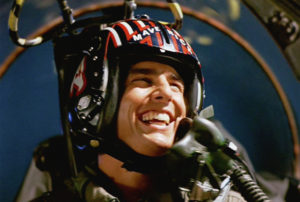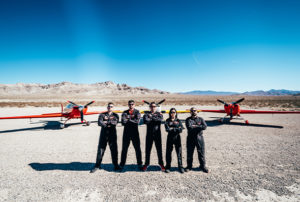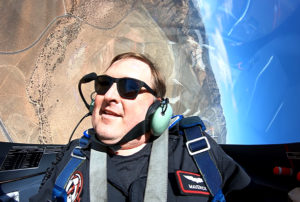I’m strapped into the front seat of an Extra 330LC, one of the most advanced aerobatic airplanes in the world, and I’m about to fly it for the first time. To be more specific, I’m about to fly an airplane for the very first time.
A radio headset acts as a mute button over my ears. The only sound I hear is my own heartbeat. Surprisingly, it isn’t racing. It’s remarkably calm, because at this moment there’s nowhere I’d rather be. In a few minutes I’ll be getting my dream shot to go up in the skies above Las Vegas with the best of the best at Sky Combat Ace. Our agenda: do a little air combat maneuvering (better known as dogfighting), along with as many multiple-g aerial stunts as my body can handle. But first, the pilot responsible for the nitty-gritty details—like, you know, takeoff and landing—needs to complete his preflight check.
The list of reasons for how I ended up in this situation is long, but distinguished, and they all involve Top Gun.
My life changed forever—as it did for so many ’80s kids—in the summer of 1986, when former teen heartthrob Tom Cruise slid into his first grown-up film role, hot shot Naval Aviator Pete “Maverick” Mitchell. Directed by the late Tony Scott on a shoestring budget of $15 million, Top Gun went on to become the year’s number one movie, grossing more than $355 million worldwide. Plus, there was the soundtrack, which won an Oscar, a Golden Globe, and a Grammy and sold more than 9 million copies, along with a home-video release that revolutionized the market.
I was too young to experience the thrill of seeing Star Wars in the theater, but for me Top Gun’s opening sequence was every bit as jaw-dropping as the sight of an Imperial Star Destroyer. If it’s been a while since you’ve seen it, the film begins with a dramatic montage set on the flight deck of the USS Enterprise. The afterburners of an F-14 Tomcat roar, and Kenny Loggins, the undisputed King of Movie Soundtracks, welcomes us to the “Danger Zone” as the iconic fighter jet is catapulted off the ship and into the twilight. My G.I. Joe Sky Striker had come to life on the big screen, right before my 10-year-old eyes.

By the time the end credits rolled, all I wanted to do was watch Top Gun again and again—which ended up being easy, thanks to the movie becoming a cable-TV staple for decades. (I’ve had at least 300 viewings. It happens.) I’m not the only one, either; Top Gun became one of the most referenced and imitated films in history, and last year, a sequel, Top Gun: Maverick, was due, at long last, to hit theaters. Unfortunately, the release was bumped back (it’s now set for next May), so I decided to make the short hop from Los Angeles to Las Vegas to see if Sky Combat Ace could satisfy my need for speed.
Founded in 2011 by Richard “Tex” Coe, an Air Force veteran who flew the F-16 Fighting Falcon during a career that took him around the world, Sky Combat Ace brings the thrill of acrobatic flying to the general public. Tex hatched the idea during occasional assignments when he gave “incentive rides” in a fighter jet to VIPs or ground crew. Las Vegas seemed like a target-rich environment to find the sort of thrill seekers who might frequent Sky Combat Ace, and the company quickly blossomed; it now has locations in San Diego and Lake Tahoe, with plans for more.
Of course, with a sticker price of nearly $30 million, the F-16 (or, for that matter, the F/A-18E Super Hornet featured in Top Gun: Maverick) isn’t the most practical vehicle to use as the foundation for a business. Compared to a military fighter jet, the Extra 330LC is a gnat, but it costs a much more reasonable $500,000, and the tandem seat German-built airplane comes with two sets of flight controls, one for the pilot in the rear and one for the passenger up front. Its lone propeller and 330-horsepower air-cooled flat-six engine (very similar to what you’d find under the hood of a classic Porsche 911) are no match for the twin turbofan engines that are capable of hurtling a Super Hornet across the sky at over 1,200 nautical miles per hour, but the Extra does have two advantages: Its agility and strength-to-weight ratio are both off the charts. With a roll rate of over 400 degrees per second, it can do a full spin nearly as fast as you can blink, and its carbon-fiber construction gives it the strength to pull more g’s than a Super Hornet, while tipping the scales at a tiny fraction of the jet’s weight.
Those figures dance in my head as I make the quick drive from my Downtown Las Vegas hotel to Henderson Executive Airport, setting the mood by listening to “Danger Zone” seven times in a row (not that I was counting). The facility is so small that it’s blocked from view by the generic office park buildings lining its perimeter, but the logo of an Extra caught in the crosshairs makes it easy to spot. And the moment I step inside, I realize I’ve entered a whole new world. Welcome to fighter pilot fantasy camp.
The small lobby hums with activity. The first flight of the day just wrapped up, and I’m one of three aspiring aces there for the next session. We don’t even bother trying to hide our grins. “It doesn’t matter how cool people feel walking in the door,” Tex says. “The coolness drops, and they feel like kids again.”

After getting fitted for flight suits, we pick out our call signs from a list of options that could fill a small-town phone book. Before I even have a chance to make my choice, Tex slaps a “Maverick” patch on the Velcro landing pad on my chest. “Heard we had a Top Gun fan today,” he says. “Welcome, Maverick.”
I’m going up with Tex, while his enthusiastic colleagues, Sara “DareDevil” Velez and Scott “McFly” McDonald (all the pilots are certified instructors), are taking the other two members of the group. DareDevil escorts us upstairs for a pre-flight briefing. As we settle into leather chairs that have us feeling as if we’re in the ready room of an aircraft carrier, she walks us through a video of what to expect. We watch skateboarding legend Tony Hawk, riding in the front seat of an Extra, break into a massive smile as he gets inverted again and again. We also go through some safety procedures, which helps eliminate any preflight jitters.
You don’t climb into an Extra as much as you contort yourself into it. It’s a race car with wings—anything that isn’t vital is stripped away—and the plane’s small stature really becomes apparent when Tex pushes it out of the hangar like a cyclist wheeling a bicycle out of the garage for a Sunday spin.
As Tex gets in the two-man cockpit behind me—much more smoothly than I managed—and pulls the canopy shut, I find myself thinking, I can’t believe I’m doing this. On our taxi to the runway, he double-checks that I really am up for anything; his team tailors each flight to the customer’s comfort level, starting with easy stunts before progressing further. I confirm, anything, even though I know my ego may be writing a check my body can’t cash. This is a bucket-list moment, and besides, there’s an emergency bag within easy reach.
I feel the first sign of the Extra’s capabilities right at takeoff. You know the thrill of a rollercoaster’s first drop? It’s like that, except going up. Tex gets us up to elevation and levels us out, then turns the controls over to me. It’s a perfect bluebird day, and we’re pointed toward Red Rock Canyon; all I have to do is keep us on course. Even though what I’m doing is the aerial equivalent of learning to drive by getting behind the wheel of a Shelby Cobra while it’s already going 160 mph, the flight controls are interconnected, so Tex can take over at any time. And unlike with a race car, which the driver has to actually keep on the track, the wide-open sky gives plenty of room to run. That’s a good thing, because the Extra is a bit twitchy. Decades of watching Maverick wrenching the stick of his F-14 back and forth did not prepare me for the surgeon’s touch required by this snarling cougar of a plane.
As DareDevil and her copilot pull alongside us, Tex takes the controls back and says over the radio, “We got a Top Gun fan in the house. I think we might need to do some international diplomacy.” (To people of a certain age, Top Gun one-liners serve as a sort of secret handshake; needless to say, Tex and I are on the fast track to friendship.)
“Copy that. We’re going up.” DareDevil’s reply crackles through with all the normalcy of a drive-thru worker acknowledging a request to hold the pickles, but in one seamless move, her plane gains altitude and flips over. Tex slides underneath, and he doesn’t have to tell me what hand signal to give. We flash each other one-finger salutes, and laughter fills the comms channel.
With the pleasantries out of the way, Tex passes back the controls and orders me to go shoot her down. SCA’s fleet is equipped to play midair laser tag, and after doing some of that pilot stuff, I coax us into a perfect firing position. The laser trips a sensor on DareDevil’s plane that releases a brief plume of acrobatic smoke oil to indicate my virtual shot is right on target. The moment is such sensory overload that I can’t even remember my name, but I do blurt out, “Splash that sucker!”—much to Tex’s delight.

Our successful dogfight has me feeling pretty arrogant, and I’m ready to turn and burn my way through some stunts. Tex starts nice and easy, executing a simple barrel roll, then guiding me through one via the radio. With each successful stunt, we level up to a higher degree of complexity—meaning more g-forces. My arrogance is short-lived; I can’t tell you exactly how many g’s we pull, because once the needle of the meter crosses six, my eyelids become too heavy to keep open. The feeling is surreal; I want to laugh, but I can’t, because my internal organs seem to be getting flattened by an invisible steamroller.
The final stunt is a hammerhead, which involves taking the Extra straight up at full power and then, right before it stalls out, nudging the stick so the plane does a cartwheel and dives back down to the original starting point. This is my “Talk to me, Goose” moment, except instead of clutching my best friend’s dog tags for inspiration, I keep my hand on that emergency bag.
The return to base is all business—no buzzed towers or circus fly-bys—but as we pull into the hangar, Tex makes the Extra do a little tail slide that is such a perfect exclamation point to the day I can’t help but laugh one more time. The flight has left me in a euphoric haze of adrenaline and exhaustion—a nearly 30-minute ride that makes the world’s most extreme roller-coaster feel like a merry-go-round will do that to a person—and Tex, who looks about as winded as if he just stepped outside to check his mailbox, has to help me climb out of the cockpit.
“How many activities can almost make you sick,” he says, “and you still think it’s the greatest thing ever?”
I ponder the question as I catch my breath, and I realize there’s only one way to answer. Standing as tall as I can in my sweat-soaked flight suit, I tell him, “You can be my wingman anytime.”
